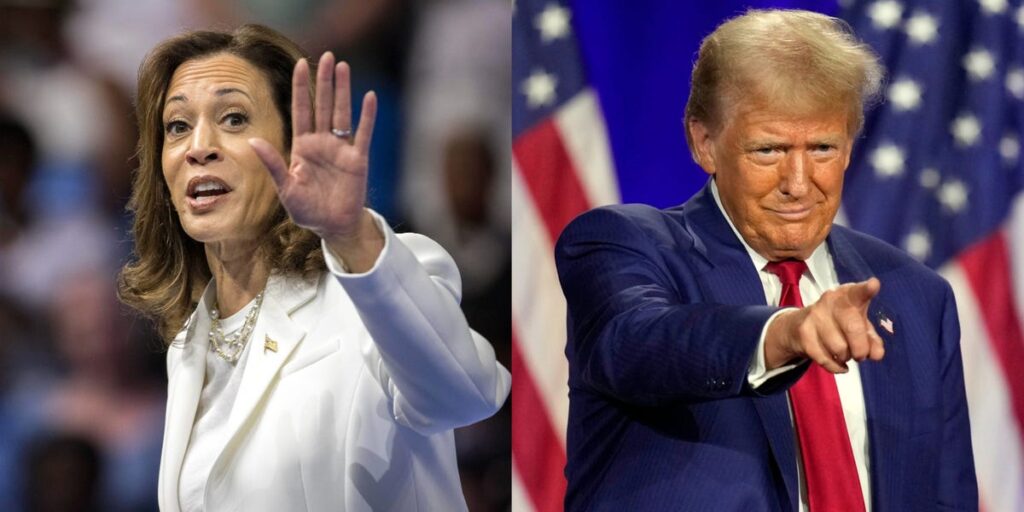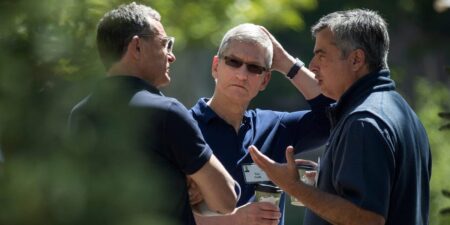- Two weeks from Election Day, polling in the battleground states shows that the race remains tight.
- A newly-released Washington Post-Schar School poll showed Harris ahead 49%-48% in the swing states.
- Harris and Trump are aiming to win in the Sun Belt, but there are challenges for both candidates.
With two weeks to go before Election Day, the contest between Vice President Kamala Harris and former President Donald Trump remains incredibly close in the seven swing states — with no clear polling leader in any one state.
It’s a recurring theme in a contest where both candidates are looking to firm up voters in their respective coalitions while also winning crossover support that could secure them victory.
Harris is aiming to boost her standing with Black men, Latino voters, and young voters, while also making appeals to independents and moderate Republicans to back her candidacy. Meanwhile, Trump continues to rally conservatives, while working to narrow the longstanding Democratic Party edge among Black and Latino voters.
The economy remains the dominant issue in the race.
Harris has repeatedly spoken about her middle-class upbringing and how she would focus on cost-of-living issues and affordable housing as president. But Trump remains more trusted on economic issues, which has buoyed his candidacy all year.
Here’s a look at how both candidates are currently faring in key battleground states as Election Day nears.
The overall picture
A newly-released Washington Post-Schar School poll — which was conducted from Sept. 30 through Oct. 15 — showed Harris ahead of Trump by one percentage among likely voters (49% to 48%) across the swing states. The surveyed states included Arizona, Georgia, Michigan, Nevada, North Carolina, Pennsylvania, and Wisconsin.
Among the states, Harris performed the strongest against Trump in Georgia (51% to 47%) and Wisconsin (50% to 47%), while Trump had his biggest advantages over Harris in Arizona (49% to 46%) and North Carolina (50% to 47%).
The remaining states are even tighter: Harris led by two points (49% to 47%) in Pennsylvania and Michigan, while both candidates were tied (48% to 48%) in Nevada.
Despite the millions of dollars being pumped into each state, which for voters comes through mostly in the form of ads, the nature of the race hasn’t changed. While Harris had slightly larger leads in September in several of the swing states and in national polling, her campaign has indicated that they always anticipated a tight race.
“We built an operation that can win close races on the ground, expecting that,” Harris battleground state director Dan Kanninen recently told NBC News. “And truthfully, one of the seven has as good a chance as any other to be the tipping-point state.”
A “Blue Wall” battle
For Harris, winning Michigan, Pennsylvania, Wisconsin, and Nebraska’s 2nd Congressional District — along with the contingent of solidly Democratic states that are almost certain to back the vice president — offers her the clearest pathway to securing 270 electoral votes.
In such a scenario, she wouldn’t need to win Arizona, Georgia, Nevada, or North Carolina to secure victory. However, Harris isn’t pursuing a singular electoral strategy and is working hard to win the states across the board.
But the fact remains that the “Blue wall” states of Michigan, Pennsylvania, and Wisconsin are states that Democrats dearly want to hold onto this year. All three states have voted for the same presidential candidate in tandem since 1992.
Harris in recent weeks has campaigned with former Republican congresswoman Liz Cheney, whose resistance to Trump’s election claims and work on the Jan. 6, 2021, committee have endeared her to many independents and voters who remain on the fence about the former president. It’s why Cheney has already joined Harris on the campaign trail in Michigan and Wisconsin, where the pair have emphasized issues pertaining to the preservation of democracy.
The vice president’s two-and-three point leads in Michigan and Wisconsin, respectively, are within the margins of error. And both campaigns know this race will likely be decided by the slimmest of margins, with every attainable voter wielding immense power in a region where the economy and abortion rights will also play critical roles in the race.
Warning signs in the Sun Belt
Trump is looking to flip Arizona and Georgia, states that he won in 2016 but lost to now-President Joe Biden in 2020. And he’s campaigning to keep North Carolina in his column and potentially become the first Republican presidential nominee to win Nevada since George W. Bush won it in 2004.
The former president has repeatedly sought to link Harris to Biden, whose unpopularity is tied in part to the negative feelings that many voters have regarding issues like inflation and housing affordability.
While Trump appeared to be cruising to a sweep of the Sun Belt swing states based on polling in the months before Biden exited the presidential race, Harris reversed Biden’s slide and has made the region’s battlegrounds a real contest.
But warning signs remain for both candidates.
Even with Biden’s electoral gains in 2020, states like Arizona and Georgia had long been Republican strongholds, and a more conventional Republican like former South Carolina Gov. Nikki Haley likely wouldn’t struggling with moderate Republicans in the way that Trump has been throughout his campaign. It’s a reason why the suburbs of Phoenix and Atlanta remain vote-rich battlegrounds; Harris has sought to court the sort of moderate voters who in the past backed Republican presidential candidates like Bush and 2012 GOP presidential nominee Mitt Romney.
The latest Atlanta Journal-Constitution poll of the presidential race in Georgia showed Trump ahead 47% to 43%, among likely voters, with eight percent of respondents still undecided. It’s a positive sign for Trump, who has campaigned extensively throughout the state.
In the poll, Harris is earning the support from roughly 74% of Black voters, a robust figure. But it’s well below the 88% support that Biden received from Black voters in Georgia four years ago. And the poll also showed that nearly 18% of Black voters remained undecided, in a state where Black voters could make up roughly 30% of the electorate or more.
Also, despite Trump’s lead in the survey, he only had a two-point advantage with voters aged 65 and older, a group that’s generally been strong for him. Harris’ competitiveness with Trump among older voters is a reminder that Georgia may have been a conservative bastion in the past but it’s now highly competitive.
Read the full article here
















